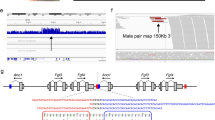Summary
Mice homozygous for the Extra-toes mutation (Xt/Xt) die perinatally with multiple malformations involving the brain, the eye, the nasal mucosa, the face and the skeleton. We have investigated the development of the eye defect in Xt/Xt embryos until late gestation. In early midgestation, three classes of homozygotes can be identified: some form an apparently normal optic cup and are associated with an apparently normal lens vesicle, some have distorted optic cups with abnormal and small lens vesicles, and others do not form an optic cup and have no lens placode or vesicle. In late gestation, some embryos have obviously continued to develop small eyes, which develop coloboma because the optic fissure in the optic nerve does not close. The others show degeneration of the optic nerve and eye cup, with no remnants of lenses. Even in the absence of an eye in these mutants, extra-ocular muscles develop. Upon comparison with other mouse mutants with eye defects, our data suggest that the malformation of the eye in Extra-toes homozygotes is due to the defective optic vesicle, and not as previously stated because of generic forces interfering with lens induction.
Similar content being viewed by others
References
Anderson S, Ede DA (1987) Eye development in the normal and Pupoid foetus (pf/pf) mutant mouse. Anat Embryol 176:243–249
Anderson S, Ede DA, Watson PJ (1985) Embryonic development of the mouse mutant pupoid foetus (pf/pf). Anat Embryol 172:115–122
Breitman ML, Bryce DM, Giddens E, Clapoff S, Gohring D, Tsui L-C, Klintworth GK, Bernstein A (1989) Analysis of lens fate and eye morphogenesis in transgenic mice ablated for cells of the lens lineage. Development 106:457–463
Couly GF, LeDouarin NM (1985) Mapping of the early neural primordium in quail-chick chimeras. I. Developmental relationships between placodes, facial ectoderm and prosencephalon. Dev Biol 110:422–439
Couly GF, LeDouarin NM (1987) Mapping of the neural primordium in quail-chick chimeras. II. The prosencephalic neural plate and neural folds: implications for the genesis of cephalic human congenital abnormalities. Dev Biol 120:198–214
Henry JJ, Grainger RM (1987) Inductive interactions in the spatial and temporal restriction of lens-forming potential in embryonic ectoderm ofXenopus laevis. Dev Biol 124:200–214
Henry JJ, Grainger RM (1990) Early tissue interactions leading to embryonic lens formation inXenopus laevis. Dev Biol 141:149–163
Hogan BLM, Horsburgh G, Cohen J, Hetherington CM, Fisher G, Lyon MF (1986) Small eyes (Sey): a homozygous lethal mutation on chromosome 2 which affects the differentiation of both lens and nasal placodes in the mouse. J Embryol Exp Morphol 97:95–110
Hogan BLM, Hirst EMA, Horsburgh G, Hetherington CM (1988) Small eye (Sey): a mouse model for the genetic analysis of craniofacial abnormalities. Development 103 [Suppl]:115–119
Jacobson AG, Sater AK (1988) Features of embryonic induction. Development 104:341–359
Johnson DR (1967) Extra-toes: a new mutant gene causing multiple abnormalities in the mouse. J Embryol Exp Morphol 17:543–581
Johnson DR (1969a) Brachyphalangy, an allele of Extra-toes in the mouse. Genet Res 13:275–280
Johnson DR (1969b) Trypan Blue and the Extra-toes locus in the mouse. Teratology 3:105–110
Kaufman MH, Webb S (1990) Postimplantation development of tetraploid mouse embryos produced by electrofusion. Development 110:1121–1132
Lyon MF, Morris T, Searle AG, Butler J (1967) Occurrences and linkage relations of the mutant “extra-toes” in the mouse. Genet Res 9:383–385
Narbaitz R, Marino I (1988) Experimental induction of microphthalmia in the chick embryo with single dose of Cisplatin. Teratology 37:127–134
Pohl TM, Mattei M-G, Rüther U (1990) Evidence for allelism of the recessive insertional mutation add and the dominant mouse mutation extra-toes (Xt). Development 110:1153–1157
Scholtz CL, Chan KK (1987) Complicated colobomatous microphthalmy in the microphthalmic (mi/mi) mouse. Development 99:501–508
Spemann H (1901) Über Korrelationen in der Entwicklung des Auges. Verh Anat Ges 15:61–79
Ten Cate G (1953) The intrinsic development of amphibian embryos. North-Holland, Amsterdam
Theiler K (1972) The house mouse. Development and normal stages from fertilization to 4 weeks of age. Springer, Berlin Heidelberg
Zwaan J, Webster EH Jr (1985) Localization of keratin in the cells of the cornea in Aphakia and normal mouse embryos. Exp Eye Res 40:127–133
Author information
Authors and Affiliations
Additional information
This work was performed by A.B. in partial fulfillment of the requirements by the University of Hamburg towards the degree of Medical Doctor
Rights and permissions
About this article
Cite this article
Franz, T., Besecke, A. The development of the eye in homozygotes of the mouse mutant Extra-toes. Anat Embryol 184, 355–361 (1991). https://doi.org/10.1007/BF00957897
Accepted:
Issue Date:
DOI: https://doi.org/10.1007/BF00957897




